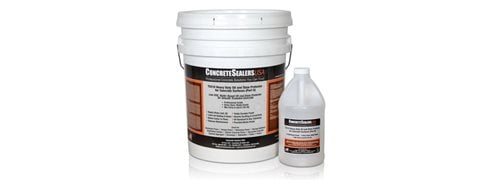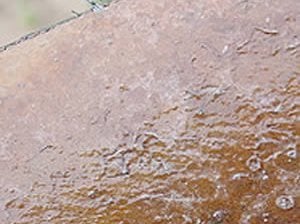- Concrete Sealer
- Comparison Chart of Concrete Sealers
- Buying Tips for Concrete Sealer Products
- Concrete Sealer Reviews: Sealer products other contractors use and recommend
- Common Questions about Concrete Sealers
- How to Remove Concrete Sealer
- Types of Sealers
- Acrylic Sealers
- Epoxy Sealers
- Penetrating Sealers
- Polyurethane Sealers
- Polyaspartic Sealers
- Application Surface
- Driveway Sealer
- Patio Sealer
- Pool Deck Sealer
- Sealers for Stamped Concrete
- Concrete Floor Sealers
- Concrete Countertop Sealers
- Pool Deck Sealer
- Exposed Aggregate Sealer
Blisters, Bubbles on Sealer Surface
- Question:
-
Shortly after applying a solvent-based acrylic sealer, tiny blisters and bubbles appeared on the surface of the sealer. What are these, and how do I get rid of them?
- Answer:
-
According to several coating chemists in my resource network, as well as from my own personal experience, bubbles and blisters in sealers and coatings are always a concern. While they don't always occur, there remains a chance they can show up. As stated in my previous Q&As on this topic, there is always a trigger mechanism for sealer issues (bubbles and blisters in this case). Finding out what that trigger is may not be easy.
Need professional help with your sealer problems? Find concrete contractors near me.
Most sealers with less than 100% solids cure by "evaporative technology." The liquid portion of the sealer (water, xylene, acetone, etc.) is used to make transport and application of the sealer possible. Once the sealer is applied, the liquid evaporates into the atmosphere leaving the solid plastic portion of the sealer on the surface. During the evaporation phase, the solid plastic gets hard.
It is during this curing phase that air and other gases need to escape. If the sealer dries too fast (such as on hot days), too slow (on cold days), or the top dries before the bottom (due to wind or sun exposure or being applied too thickly), the potential is there to trap gas and create blisters and bubbles. Picture air trying to move through thick maple syrup. When the syrup is cold, the air will move very slowly. Heat that syrup up a bit, and it thins, allowing the air to move much faster. Too much heat, and the syrup itself starts to cook. This is why following the sealer manufacturer's recommended application guidelines is very important.
As far as getting rid of the blisters and bubbles, there are three common remedies depending on type of sealer and how many and how deep the bubbles and blisters run. For solvent-based sealers, blisters and other surface defects can usually be removed with a solvent bath (wetting the surface with acetone or xylene). This sometimes works with water-based sealers, but testing first is always recommended. Sometimes simple surface blisters in a solvent system can also be removed just by applying an additional coat of the same sealer. Surface sanding and re-application of the sealer has also worked in spot applications. If bubbles run deep, then the sealer is usually on too thick, and a solvent bath along with back rolling may be needed. As a last resort, the surface can be stripped of all sealer, cleaned, and resealed. You can learn more about sealing and repair of blisters and bubbles by calling the technical department of most any major sealer manufacturer.
Author Chris Sullivan, ConcreteNetwork.com technical expert and vice president of sales and marketing for ChemSystems Inc.
Return to How to Fix Concrete Sealing Issues
 D-One Penetrating Sealer
Non-yellowing, low sheen, good adhesion
D-One Penetrating Sealer
Non-yellowing, low sheen, good adhesion
 Deep Penetrating Sealer
RadonSeal - Waterproofs & strengthens.
Deep Penetrating Sealer
RadonSeal - Waterproofs & strengthens.
 Clear-Seal by Increte Systems
Seals and protects decorative surfaces.
Clear-Seal by Increte Systems
Seals and protects decorative surfaces.
 Heavy Duty Oil & Stain Protector
TS210 - 4 gal. kit ($439.95)
Heavy Duty Oil & Stain Protector
TS210 - 4 gal. kit ($439.95)
 Premium Exterior Clear Sealer
High solids acrylic based sealer
Premium Exterior Clear Sealer
High solids acrylic based sealer
 Gem-Guard SB
Penetrating sealer that protects against salt damage
Gem-Guard SB
Penetrating sealer that protects against salt damage
 Decorative Sealers
Reactive and penetrating formulas in various levels of gloss.
Decorative Sealers
Reactive and penetrating formulas in various levels of gloss.
 Water Repellent Penetrating
Sealer for driveways, parking structures, plazas, walkways & more.
Water Repellent Penetrating
Sealer for driveways, parking structures, plazas, walkways & more.
 Clear Acrylic Concrete Sealer
$219.30 (5 gal.)
Clear Acrylic Concrete Sealer
$219.30 (5 gal.)





